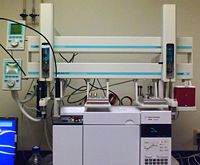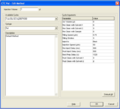Biofuels
From LEAP
| Line 93: | Line 93: | ||
== Video == | == Video == | ||
| + | |||
| + | *[[:Image:DISPTool.ppt | Dispense Tool movement]] | ||
| + | |||
| + | == Useful links == | ||
| + | |||
| + | *[[:Image:DISPTool.ppt | Dispense Tool movement]] | ||
| + | |||
| + | == Publications == | ||
| + | |||
| + | *[[:Image:DISPTool.ppt | Dispense Tool movement]] | ||
| + | |||
| + | == Other Reference material == | ||
*[[:Image:DISPTool.ppt | Dispense Tool movement]] | *[[:Image:DISPTool.ppt | Dispense Tool movement]] | ||
Revision as of 02:17, 5 February 2009

| Biofuels |
| Application Type | |
| Sample Prep and Inject | |
| Application ID | |
| Biodiesel ASTM 6584 | |
| Description | |
| Determination of Free and Total Glycerin in B-100 Biodiesel Methyl Esters by Gas Chromatography |
Contents |
Overview
Glycerin content can indicate the quality of biodiesel. Glycerin can be in the form of free glycerin or bound glycerin in the form of glycerides. Total glycerin is the sum of these. A high content of free and total glycerin can lead to buildup in fuel tanks, clogged fuel systems, injector fouling and valve deposits. Unrelated glycerides and free glycerin make the product behave more like soap rather than fuel.
ASTM Method D6571 specifications serve as the benchmark which identifies the standards that pure biodiesel (B100) must meet before being used as a fuel or blended with petrodiesel. The US National Biodiesel Board has adopted the ASTM biodiesel specification and analytical methodology. ASTM recommends test method D6584 for the analysis of glycerin in biodiesel fuel by gas chromatography.
Gas chromatography can also serve as a tool for process troubleshooting during biodiesel production to ensure trouble-free operation of the fuel in diesel engines. Monitoring the level of free glycerin and any unrelated mono-, di-, and triglycerides will indicate the efficiency and progress of the chemical reaction during the process of making biodiesel.
ASTM Method D6584 provides for the quantitative determination of free and total glycerin in B-100 methyl esters by gas chromatography. The range of detection for free glycerin is 0.005 to 0.05 mass%, and total glycerin from 0.05 to 0.5 mass %. This method is not applicable to vegetable oil methyl esters obtained from lauric oils, such as coconut oil and palmkernel oil.
Significant Markets
- Biodiesel Manufactures
- Biodiesel Blenders
ASTM Method D684
9. Calibration and Standardization
9.2 Standard Solutions – Prepare the five standard solutions in Table 3 by transferring the specified volumes by means of Microliter syringes to 10mL septa vials. Add to each of the five standard solutions 100uL of MSTFA. Close the vial and shake. Allow the vial to stand for 15 to 20 minutes at room temperature. Add approximately 8 mL n-Heptane to vial and shake.
| Standard Solution Number | 1 | 2 | 3 | 4 | 5 |
|---|---|---|---|---|---|
| uL of glycerin stock solution | 10 | 30 | 50 | 70 | 100 |
| uL of monoolein stock solution | 20 | 50 | 100 | 150 | 200 |
| uL of diolein stock solution | 10 | 20 | 40 | 70 | 100 |
| uL of triolein stock solution | 10 | 20 | 40 | 70 | 100 |
| uL of butanetriol stock solution | 100 | 100 | 100 | 100 | 100 |
| uL of tricaprin stock solution | 100 | 100 | 100 | 100 | 100 |
9.4 Standardization
9.5 Inject 1 uL of the reaction mixture into the cool-on-column injection port and start the analysis.
10. Procedure
10.1 Weigh to the nearest 0.1 mg approximately 100 mg of sample directly into a 10 mL septa vial. Using Microliter syringes, add exactly 100 uL of each internal standard and MSTFA. Shake the vials, and allow to set for 15 to 20 minutes at room temperature. Add approximately 8 mL of n-Heptane to vial and shake.
10.2 Inject 1 uL of the reaction mixture into the cool on-column injection port and start the analysis.
LEAP's Approach
The Lower PAL is the Prep PAL and runs on Cycle Composer Software. All of the sample prep is performed with this PAL. There is a 100ul syringe for the solvent transfers. There are (7) 2mL solvent locations. There is a DISPTool that is hooked up to a 5 mL dilutor syringe for the 8 mL Heptane addition. There is a fast wash station that Wash1 is filled with Toluene and Wash 2 is filled with Heptane. There is an agitator that is set at 35 deg C and 500RPM to do the mixing.
The Upper PAL is the Inject PAL and runs under ChemStation Software control. This requires Agilent CTC Control Software supplied by Agilent. It is using a 5 ul syringe with a tapered needle to do 1 ul on column injections into the rear injection port. There is a fast wash station that Wash1 is filled with Toluene and Wash 2 is filled with Heptane.
The expected Sample Prep Time is approximately 26 minutes
The expected GC Runtime is approximately 31.81 minutes
The expected GC Cool down time is approximately 7 minutes
Software Control
The Lower PAL is the Prep PAL and runs on Cycle Composer Software.
The Upper PAL is the Inject PAL and runs under ChemStation Software control.








